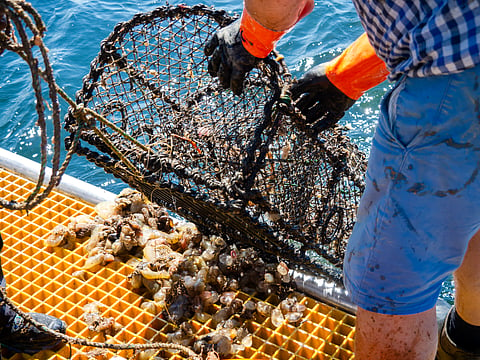

Ghost fishing occurs when lost or abandoned gear remains active on the seabed, trapping and killing fish and crustaceans for many years.
Photo: Arnbjørg Aagesen / Institute of Marine Research.
Thousands of fishing traps such as lobster pots are lost along the Norwegian coast each year, continuing to catch marine life long after they have been abandoned.
Norway's Institute of Marine Research (HI) has estimated that around 15,000 lobster pots were lost in 2017 alone, with more than 24,000 losses reported to the Directorate of Fisheries since then.
In response to this growing problem of ghost gear, Norway's Fisheries and Aquaculture Industry Research Funding (FHF) has announced it is backing a project investigating the feasibility of a national deposit scheme for old fishing traps.
The proposed deposit scheme would see monetary reward given for the handing in of old or unwanted fishing traps such as lobster pots, encouraging fishers to bring their old gear back to land for proper disposal or recycling rather than leaving it at sea.
The FHF-funded project, led by marine research and advisory company SALT and consultancy firm Menon Economics, runs until the end of 2026, and is described by SALT project manager Carl Höjman as "an exercise in weaving together economic theory, a changing waste management system, and many different stakeholders along the trap value chain."
“Many have probably wondered whether a deposit scheme would be a smart way to tackle trap loss. That’s why it’s particularly gratifying that FHF is now enabling a thorough study of the issue," Höjman added.
The project has produced two initial reports on the current situation and the possible design of the proposed scheme. The first report, prepared by SALT, describes current patterns of trap use and disposal, finding that both commercial and recreational fishers lose large amounts of gear each year. Most of the recovered traps are currently sent to incineration or landfill, with waste management companies generally supportive of the idea of a deposit system, but pointing to a need for better sorting and recycling options.
The second report, by Menon Economics, assessed the potential socio-economic impact of such a scheme, concluding that it could be effective, but only if implemented carefully, through easy access to collection points, as well ensuring monetary reimbursement at a level sufficient to incentivise returns but low enough to prevent misuse.
Lost gillnets without biodegradable threads can continue fishing for up to ten years. Pictured: fishing traps recovered from the Inner Oslo fjord in 2022.
Photographer: Stine Hommedal / Institute of Marine Research
“This shows that we now have a knowledge-based recipe for how a deposit system can be designed to actually reduce ghost fishing," said Eduardo Grimaldo, FHF’s head of fisheries, via a press release. "The reports confirm that a deposit scheme can be an effective tool, but only if it is combined with producer responsibility, good collection solutions and the right deposit amount.”
The next stage of the project will focus on developing detailed proposals for how the deposit system would operate, including a pilot version, FHF said.
